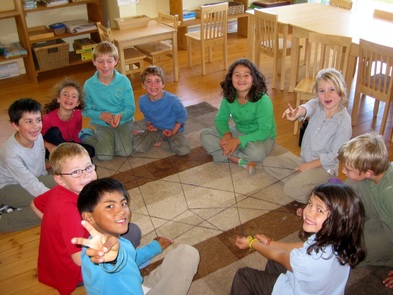Small Class Benefits

Beachcombers Academy class size is maximum 16 to 18 students per class for core academics; classes are combined for afternoon activities. For child care it is a maximum 16 students.
Simply put, smaller class sizes allow for more personalized attention for students, better educational results, and an environment which can support the well-being of the whole child.
“Smaller class size enhances learning for a basic common sense reason -- it helps teachers in getting to know the kids,” says Don Ernst, University of Arkansas, and consultant to government on education reform.
A large-scale study defined small class size as 15 to 17 students. Benefits to small class sizes included: better student participation and engagement, improved mastery of basic skills, increased student achievement, effective teaching methods, improved classroom environment, more inclusive environment, better student and teacher morale, and a psychological sense of community. 1
Simply put, smaller class sizes allow for more personalized attention for students, better educational results, and an environment which can support the well-being of the whole child.
“Smaller class size enhances learning for a basic common sense reason -- it helps teachers in getting to know the kids,” says Don Ernst, University of Arkansas, and consultant to government on education reform.
A large-scale study defined small class size as 15 to 17 students. Benefits to small class sizes included: better student participation and engagement, improved mastery of basic skills, increased student achievement, effective teaching methods, improved classroom environment, more inclusive environment, better student and teacher morale, and a psychological sense of community. 1
Long-term Benefits of Small Class Size

Educating the whole child.
Research shows exciting long term benefits of small primary class sizes. Small primary classes promote “a strong foundation for a lifetime of continuous learning,” according to a published review (October 2012) by the US National Council of Professors of Educational Administration.1
This extensive research review found that students who had at least four years of small class size during primary school had long-term benefits:
1. Students were more likely to take college entrance exams.
2. The odds of high school graduation were increased by 80%. The effects on graduation rates were larger with each additional year of small-class participation in primary school.
3. Students were more likely to take advanced course work in high school such as languages and mathematics. Both poor and affluent students were affected similarly.
A 2011 study found that, “smaller [primary] classes increase the likelihood of earning a college degree…and shift students towards high-earning fields such as…science, technology, engineering and medicine, business and economics.” 2
Beachcombers Academy also supports the development of the whole child including those deeply valuable aspects of education which are difficult to quantify: respect, cooperation, and caring communication. Small class sizes are essential to enable teachers to provide this wonderful kind of education.
1. Class-Size Policy: The STAR Experiment And Related Class-Size Studies, Achilles, C.M., et all., National Council of Professors of Education Administration, 2012.
2. Experimental Evidence on the Effect of Childhood Investment on Postsecondary Attainment and Degree Completion. Dynarski, S., Hyman, J., and Schanzenback, D.W., US National Bureau of Economic Research Working Paper, 2011.
This extensive research review found that students who had at least four years of small class size during primary school had long-term benefits:
1. Students were more likely to take college entrance exams.
2. The odds of high school graduation were increased by 80%. The effects on graduation rates were larger with each additional year of small-class participation in primary school.
3. Students were more likely to take advanced course work in high school such as languages and mathematics. Both poor and affluent students were affected similarly.
A 2011 study found that, “smaller [primary] classes increase the likelihood of earning a college degree…and shift students towards high-earning fields such as…science, technology, engineering and medicine, business and economics.” 2
Beachcombers Academy also supports the development of the whole child including those deeply valuable aspects of education which are difficult to quantify: respect, cooperation, and caring communication. Small class sizes are essential to enable teachers to provide this wonderful kind of education.
1. Class-Size Policy: The STAR Experiment And Related Class-Size Studies, Achilles, C.M., et all., National Council of Professors of Education Administration, 2012.
2. Experimental Evidence on the Effect of Childhood Investment on Postsecondary Attainment and Degree Completion. Dynarski, S., Hyman, J., and Schanzenback, D.W., US National Bureau of Economic Research Working Paper, 2011.

